|
Elizabeth Avery Meriwether
... Rebel, Writer
and
Suffragist |
|
|
|
|
|
|
 |
Elizabeth Avery Meriwether was a Tennessee author,
publisher and prominent early activist in the women's
suffrage movement. Always out-spoken, she became
involved with this movement in Memphis, after the Civil
War. She would go on to present suffrage petitions
at both the Democratic and Republican national conventions
in 1880. Because she was a writer, she left behind a
thorough written legacy so we're able to examine her
relationship with the Confederacy. Elizabeth
Meriwether was a slave owner, a Confederate wife, devoted
mother , personal friend of Jefferson Davis and Nathan B.
Forrest. She was also a prominent figure in Memphis
and later in St. Louis. She thought of herself as a
defender of the "lost cause" who also
passionately fought for women's rights. |
|
Elizabeth Meriwether |
|
|
|
|
|
|
|
|
|
|
|
|
|
|
|
|
Click on small
photos to see an enlargement |
|
|
|
|
|
|
|
|
Elizabeth Edmonds Avery Meriwether was born in Bolivar,
Tennessee January 19, 1824 to Nathan and Rebecca Jones Rivers
Avery. Her father was a physician-farmer and her mother
was the daughter of a Virginia planter. Elizabeth had two
sisters (Amanda and Cornelia Estelle), and a brother, William Tecumsah
Avery. According to her book, the family lived in a log
cabin home. It was a comfortable life. |
 |
| |
Elizabeth
Meriwether |
|
|
|
 |
 |
 |
| Bolivar:
Little Courthouse - 1824 |
Bolivar:
The Pillars House- 1826 |
Bolivar:
Courthouse |
|
|
|
|
|
|
 |
In 1835, when she was 11 years old, financial difficulties
prompted the family's move to Memphis. Elizabeth's
father died there in 1846, followed by her mother's death the
next year. To make ends meet, her brother, William had to
go to work while she and a sister operated a small school in
their home. There are no listings for the family at this
time in the Memphis directories so we don't know where they
lived in the city.
|
|
Memphis c.
1860 |
|
|
|
|
 |
 |
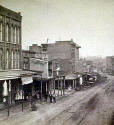 |
 |
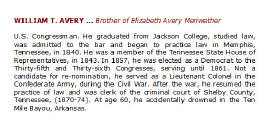 |
 |
| Memphis 1860s |
Memphis 1870 |
Beale 1860s |
William T.
Avery |
W. T. Avery
Bio |
Amada Avery |
|
|
|
|
|
|
|
|
|
|
|
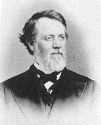 |
In
1852 Elizabeth married Minor Meriwether an engineer and a
lawyer. His late father had asked the couple to sell their
inherited land and to free the slaves and then repatriate them to
Liberia (Later Elizabeth will accept a gift of a household slave
from her brother). Their marriage was a happy union and
they had three sons - Avery, in 1857, Rivers, in 1859, and Lee,
in 1862. Lee, of course was named for General Robert E.
Lee. Based on the Memphis Directories, the Meriwethers
lived at 35 Monroe Avenue during the early years of their
marriage. Minor's brother Niles lived in Memphis and was
also an engineer. He married Lide Smith who will become
another prominent Memphis Suffragist . |
| Minor
Meriwether |
|
|
|
|
|
|
|
|
|
|
|
|
|
Elizabeth, the
Rebel ! |
|
|
 |
When
the Civil War began, Minor Meriwether joined the Confederate
army and served with Nathan Bedford Forrest, as an engineer
officer. Most of his war duty was constructing defenses
and building and re-building railroads. Elizabeth is
left alone to raise two boys while she is pregnant with the
third. It's during this period that she becomes very vocal
in her defense of the Confederate "cause". Soon Memphis will
fall and Union forces will occupy the city under the control of
General Grant and William T. Sherman. To disagreed with
them made one subject to arrest and the infamous Irving Block prison. Elizabeth bitterly
resented the Union forces and became so defiant that, after
several encounters, Sherman orders her to leave Memphis in 1862,
just weeks before the birth of her son. (She will write
about this experience later in "The Refugee").
|
|
Civil War |
|
|
|
|
|
|
|
|
|
On the road as a refugee
Elizabeth tries to find her husband's unit
but ultimately gives birth in a stranger's home, along the road. She then
resorts to stealing corn and selling clothing in order to have food for her
children. She even slipped back into Memphis to pay the taxes
on
her property so it wouldn't be sold at auction. Eventually Tuscaloosa, Alabama
became the end of the road. While in Tuscaloosa, Elizabeth
begins to write again, a pleasure she had enjoyed as a child. She won a competition sponsored
by the Selma Daily Mississippian offering $500 for the best short story
dealing with the war. Elizabeth wrote "The Refugee" based on
her experiences and won. This success encouraged her to
continue writing. She then wrote "The Yankee Spy"
and a newspaper planned to publish it, but that project fell through. |
 |
| |
Elizabeth |
|
|
|
 |
After
the war, Minor Meriwether purchased a Memphis home for the
family at 95 Union Avenue, on a lot were the current Peabody
Hotel is located. Since Memphis had been occupied during
the war, it hadn't suffered the destruction that most of the
South did and it was now ready for big growth.
Nathan Forrest returned home, and Jefferson Davis now lived in
the city after his pardon. And so did the "Carpetbaggers".
Everyone hated this forced "Reconstruction". There were
rumors that Minor
Meriwether assisted Nathan B. Forrest in forming the Ku Klux Klan,
and that one of the early meetings was held in Elizabeth Meriwether's kitchen.
In 1877 the Meriwether family moved to 253 Beale for 6 years.
We've not been able to locate any reason for this move. |
|
War Ends |
|
|
|
|
|
|
|
|
|
Elizabeth's family home had been confiscated by the Union during the
war. She now petitioned General Stephen A. Hurlburt in an
effort to regain title and was finally successful in her endeavor.
Ironically she was now a legal property owner and a tax payer.
Thus she was entitled to vote. But women couldn't vote!
Yet she persisted and was able to obtain a voter registration in
1872 and in 1876 she went to the polls and /they actually let her
vote. Of course her vote wasn't counted, but the important
thing to her was that she had actually voted. And to her
knowledge, she and Susan B. Anthony were the only two American Women
who had ever voted. Afterwards she rented the
Memphis Theatre and held a meeting to explain her beliefs.
|
 |
|
|
Gen S. A. Hurlburt |
|
|
|
|
|
|
|
|
|
|
Elizabeth the
Suffragist ! |
|
|
|
During the
1870s, Elizabeth combined her writing along with her interest in social
reform. She became one of first suffragettes in the South and was one of
the first women in the state to publicly push for women's
suffrage. She wrote letters to the editor of newspapers and published a
pamphlet about women's rights. In 1872 she published a small
newspaper "The Tablet" showcasing her own unique views of women's issues,
divorce law, as well as equal pay for women teachers. In 1876 she
held the first public meeting in Tennessee for women's rights, and
made one of the first public suffragist speeches in Memphis.
She was active in the Women's Christian Temperance Union, and
belonged to the National Women Suffrage Association, serving as a
national officer in 1887. She also presented suffrage petitions at both
the Democratic and Republican national conventions in 1880.
|
 |
| |
|
|
|
|
|
In 1881
she joined Elizabeth Cady Stanton and Susan B. Anthony on a
speaking tour of New England. In her book she quotes a
Northern newspaper which said "her keen sarcasm, wit and humor caused frequent bursts of
laughter and applause". Later Elizabeth's sister-in-law, Lide A. Meriwether
will form the first suffrage league in Memphis in 1889 - and the first
in the state. Together, they are an unmatched pair.
To his
credit, Minor
Meriwether always supported Elizabeth's efforts and from the very beginning insisted
on an equal partnership. To him, what was his, was hers. |
 |
| |
Suffrage
History |
|
|
|
 |
 |
 |
 |
 |
 |
| 1877 Speech |
1877 Letter
to Editor |
1877
Constitution |
1882
Lectures |
1882 Letter
to Senate |
1886 Speech |
|
|
|
|
|
|
|
|
|
|
|
|
|
|
Elizabeth, the
Writer ! |
|
|
 |
Elizabeth Meriwether's published works include two novels, "The
Master of Red Leaf" (1872), describes life on a southern
plantation before the Civil War and it present a justification of secession,
and "Black and White" (1883), plus a play, "The Ku Klux Klan,
or The Carpetbagger in New Orleans" (1877). Her other works
include "Facts and Falsehoods about the War on the South",
which was
published under the pseudonym George Edmonds in 1904, and "The
Sowing of the Swords" (1910). Her last written work was a
memoir "Recollections of 92 Years" which was serialized in many
newspapers in 1916. Her son Lee, published his mother's
memoir as a book in 1958.
|
| Elizabeth |
|
|
|
|
|
Most
of Elizabeth's works deal with the South before the war and she
always refused
to acknowledge that slavery had been a moral or social evil.
She will continue to believe that the Civil War was not about
slavery but about "States Rights". In addition, her writing continued to idealize the Confederate
"cause" as well as the
traditional racial stereotype of the OLD South, complete with black
characters who were happy, carefree, childlike, and totally unable to
govern themselves without the confines of slavery. It
seems to defy belief that a person so dedicated to "Women's
Rights" was unable to acknowledge "Civil Rights"
for all.
Elizabeth Meriwether's novels and writings are still available
from publishers and on the internet ... |
 |
| |
"Lost Cause" |
|
|
|
 |
 |
 |
 |
 |
 |
| 1872 |
1880 Review |
"The Tablet" |
1916 |
1904 |
1904 |
|
|
|
|
|
|
|
|
Elizabeth, the
Mother ! |
|
|
 |
The Meriwether boys grew into well educated and highly
respected young men. They all became lawyers like their
father, and they also wrote, like their mother. In 1882,
Avery and Lee organized a weekly newspaper called "Free Trader"
and published it from their office at 245 2nd Street.
After a few issues, they were advised that the title was
confusing and the name was changed to "Meriwether's Weekly ".
The newspaper was devoted to literary, social and political
criticism and was a well respected weekly, throughout the U.S.
Around 1882 the
Meriwether family moves from the Beale address to 286 Union Av. |
| Lee Meriwether |
|
|
|
|
 |
 |
 |
 |
 |
 |
 |
| Free Trader
1882 |
1882 "M W" |
1883
M.W. |
M W
|
1883 M W |
1883 Article |
1883 Final |
|
|
|
|
There
are also sad times among the good times for the family including an
early death for their first born son, Avery in 1883.
Newspapers in various parts of the country will print obituaries for
him ... and Elizabeth writes a special "memory"
as her therapy in losing a child. In 1896 the second Meriwether
son, Rivers suddenly dies - a "mysterious death" .
(Complete coverage of the death in "Obit-2" below) |
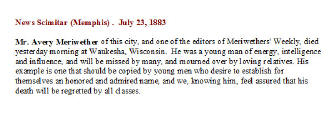 |
| |
Avery's Obit
|
|
|
|
 |
 |
 |
 |
 |
 |
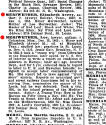 |
|
Mother's
Memory |
Avery
Tribute |
Rivers Obit |
Rivers Obit-2 |
1883 Directory |
1883 Directory |
Who's Who1903 |
|
|
|
|
Their son Lee marries in 1888 - for the 1st time. He will
marry three times and live to be 103, outliving all three of his
children as well as his three wives. Although trained as a
lawyer, his passion was writing and traveling. He combined
both in his 1887 book "How to see Europe on Fifty Cents a
day". Lee was an interesting character who loved
adventures. He really should be explored
individually rather than as a son . His many books and
articles are still available from Publishers and on the
Internet. The "Who's Who" article (above) is interesting
to compare how much space is devoted to Lee and how much to his
mother. |
 |
| |
Lee
Meriwether |
|
|
|
|
|
|
|
|
|
|
|
|
|
|
|
|
Minor and Elizabeth moved to St. Louis circa 1884-85 to
avoid another Yellow Fever epidemic. Elizabeth was 60
years old and Minor was 57. Minor continued to practice
law there until his death.
Minor
and Elizabeth built the Meriwether Mansion in the late 1800s in
what was then the most fashionable neighborhood in St. Louis -
3716 Delmar Blvd - Grandel Square. The home is
still there and has recently been renovated. |
 |
| |
Elizabeth |
|
|
|
|
|
|
|
|
|
|
|
|
|
|
|
|
A life
size bronze statute in Knoxville, Tennessee commemorates Lizzie Crozier French, Anne Dallas
Dudley and Elizabeth Avery Meriwether, three Tennessee women's rights
pioneers who fought for passage of the 19th amendment, giving women
the right to vote in 1920. This statue by sculptor Alan LeQuire, was erected in Market
Square 86 yeas after the ratification
of the 19th amendment. Elizabeth is shown on the left
representing West Tennessee. Elizabeth and Anne
also have Historical markers in Memphis and in Nashville.
We have not located a marker for Lizzie. |
 |
| |
Suffrage
Monument |
|
|
|
|
 |
 |
 |
 |
 |
|
Eliz
Meriwether |
Anne Dudle |
Lizzie French |
Memphis
Marker |
Nashville
Marker |
|
|
|
|
|
|
|
|
|
 |
 |
Elizabeth
died in St. Louis November 4, 1916, at the age of 92. She lived long
enough to see each political party finally adopt campaign planks urging
passage of a woman's suffrage amendment - but not quite long enough
to see it pass.
Minor
died 6 years before in 1910. Both are buried
at the St. Louis Bellefontaine Cemetery along with sons Rivers and
Lee. Avery was buried at Elmwood Cemetery in Memphis. |
|
Elizabeth |
Minor |
|
|
|
|
|
|
|
|
|
|
|
|
|
|
|
|
|
|
|
|
|
|
|
|
|
|
|
|
|
|
The rest of the
story ...
May
14, 2020. Robert Anderson writes:
I saw the Historic-Memphis webpage on
Elizabeth Avery Meriwether and thought you might appreciate some
further family background ...
|

|
Elizabeth’s
father Nathan Avery left the family home in New Lebanon, NY, and
went pioneering to TN. [I don’t have the reference at hand but
seem to recall he had served as a physician for the Navy in
Philadelphia during the War of 1812.) He was the eldest child
of William Thomas Avery and Phoebe Throop Avery. Phoebe’s aunt
Octavia Throop Hale was married to Enoch Hale, Nathan Hale’s
brother (I regret I have but one life…) and was a 6x
great-granddaughter of Gov. William Bradford of Plymouth Colony. |
| |
|
Widowed Phoebe and
several of the other children went pioneering to IL in 1836,
shortly after the end of the Blackhawk War. They were members
of a party that founded Galesburg, IL. This was a
group of idealists that wanted to found a college and church
community on the opening frontier. So Galesburg was founded
along with Knox College and what they called “First Church”.
The original church was shared by congregations of 2
different denominations, Presbyterian and Congregationalist.
I don’t know why
Elizabeth says the family was Quaker. There were many ministers
of these (Puritan) denominations in the family tree.
Lee Meriwether writes of visiting Uncle John Thomas Avery
in Cleveland, where Uncle John tries to introduce him to his
friend retired Gen. William Tecumseh Sherman. (Rev) John Thomas
Avery was for a while the minister of First Church in Galesburg.
Lee also mentions
Uncle John Kendall, in “My Yesteryears”. John Kendall was a
member of the Galesburg pioneers who married Nathan’s sister
Debora Avery at Galesburg. They moved back to New
Lebanon when Kendall’s father died, and John had to take over
the family business.
My 2x
great-grandfather was Elizabeth’s Uncle George. He was a deacon
at First Church. As a member of the Underground
Railroad, he helped hide escaped slaves in the church belfry.
Quaker merchants brought them to Galesburg hidden under the
merchandise in their wagons for a rest stop while on the way to
Canada.
My great-grandfather
Robert Avery was born at Galesburg. During the Civil War, he
joined the 77th Illinois Infantry Regiment. The 77th
reported to Gen. Sherman in Memphis in Nov 1862 and left with
him in Dec 1862 for the Battle of Chickasaw Bayou. This is
exactly the time when Elizabeth had her meeting with Gen.
Sherman and was banished from Memphis.
I don’t know if the
cousins knew about each other or met at this time. The
Meriwether family photo album has a picture of Uncle George and
Aunt Seraphina along with a hand written list of their
children’s names. I’ve never found mention Uncle
George or Cousin Robert in any of their writings.
Robert’s biography
(Chase the Prairie Wind, by historian Martin Litvin) never
mentions the Meriwether’s. Robert was captured at the Battle of
Mobile Bay and spent the rest of the war in Andersonville
Prison. I read that Lee once wrote an editorial
justifying Andersonville.
Just as The Meriwether’s became
noted politicians and authors, Robert became a wealthy
industrialist. He founded a
farm implement company
that by the 1890’s claimed to be the world’s largest
manufacturer of steam farm tractors. They did sell worldwide.
Curious that these two noteworthy families were silent
about each other, in spite of all the writings.
PS: after going to college in Galesburg, the son of a 24th
Tennessee Infantry Regiment veteran married a daughter of
Robert Avery. They eventually returned to his home in
Rutherford County, where his family had lived since around
1810. They were my grandparents. I attended MTSU for 2
years.
Robert Anderson ,
5/14/2020
|
|
|
|
|
|
|
|
|
|
|
|
|
|
|
|
|
|
|
|
Credits |
|
|
|
The majority of
photos on this page are in the Public Domain
The
Historic-Memphis website does not intentionally post copyrighted
photos and material without permission or credit. On
occasion a "non-credited" photo might possibly be posted because we
were unable to find a name to give credit. Because of the
nature of our non-commercial, non-profit, educational website, we
strongly believe that these photos would be considered "Fair Use.
We have certainly made no monetary gain, although those using this
website for historic or Genealogy research have certainly profited.
If by chance,
we have posted your copyrighted photo, please contact us, and we'll
remove it immediately, or we'll add your credit if that's your
choice. In the past, we have found that many photographers
volunteer to have their works included on these pages and we'll
also do that if you contact us with a photo that fits a particular
page. |
|
|
|
The "Historic-Memphis" website would like to acknowledge and thank the
following for their contributions which helped make this website
possible:
Memphis
Public Library, Memphis University Library,
Memphis Commercial Appeal, Memphis Press Scimitar, Shelby County
Register of Deeds, Historic Bolivar website, Memphis Business Men's
Club, Memphis Chamber of Commerce, Memphis Historical
Railroad Page, Memphis Heritage Inc, Beale Street Historic District,
Memphis Historic Districts, Vance
Lauderdale Family Archives, Tennessee State Archives, Library of
Congress, George Whitworth, Woody Savage and many individuals whose assistance is
acknowledged on the pages of their contributions. Special
thanks to Memphis Realtor, Joe Spake, for giving us carte blanche
access to his outstanding collection of contemporary Memphis photos.
We do not have high definition copies of the photos on these
pages. If anyone wishes to secure high definition photos,
you'll have to contact the photographer or the collector.
(To avoid any possibility of contributing to SPAM, we do not
maintain a file of email addresses for anyone who contacts us). |
|
|
|
|
|
|
|
|
|
|
|
|
|
|
|
|
|
|
| |
|
|